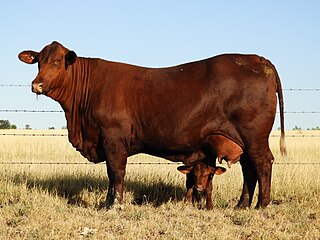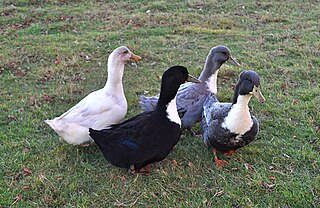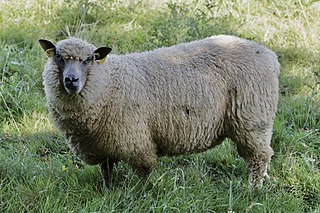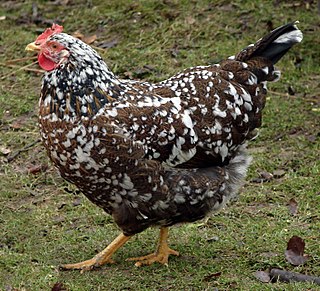
The Charolais or Charolaise is a French breed of taurine beef cattle. It originates in, and is named for, the Charolais area surrounding Charolles, in the Saône-et-Loire department, in the Bourgogne-Franche-Comté region of eastern France.

The American Pygmy is an American breed of achondroplastic (dwarf) goat. It is small, compact and stockily built. Like the Nigerian Dwarf, it derives from the West African Dwarf group of breeds of West Africa. Between 1930 and 1960, animals of this type were imported to the United States for use either as zoo animals or for research; some were later kept and bred as companion animals and established as a breed in 1975.

The Santa Gertrudis is an American breed of beef cattle. It is a taurine-indicine hybrid breed, descended from both zebu and European cattle. It was bred in the early twentieth century in Texas, and received official recognition in 1940. It has been exported to many countries including Australia, Brazil and South Africa, and has contributed to the development of a number of modern breeds, among them the Barzona and the Droughtmaster.

The Oxford Down is a British breed of domestic sheep. It was developed in the 1830s by cross-breeding of Hampshire Down and Southdown ewes with Cotswold rams. It is reared primarily for meat.

The Swedish Blue or Blue Swedish is a Swedish breed of domestic duck. It originated in the former dominion of Swedish Pomerania – now in north-west Poland and north-east Germany – and is documented there from 1835. It is closely similar to the Pomeranian Duck from the same general area, differing mainly in its white primary feathers.

The Dorset Horn is an endangered British breed of domestic sheep. It is documented from the seventeenth century, and is highly prolific, sometimes producing two lambing seasons per year. Among British sheep, it is the only breed capable of breeding throughout the winter.

The Anglo-Nubian is a British breed of domestic goat. It originated in the nineteenth century from cross-breeding between native British goats and a mixed population of large lop-eared goats imported from India, the Middle East and North Africa. It is characterised by large, pendulous ears and a convex profile. It has been exported to many parts of the world, and is found in more than sixty countries. In many of them it is known simply as the Nubian.

The Sussex is a British breed of red beef cattle from the Weald of Sussex, Surrey and Kent, in south-eastern England. Its traditional use as a draught ox on the Weald continued into the twentieth century. From the late nineteenth century it began to be selectively bred for beef production. It has been exported to many countries of the world; the largest population is in South Africa, where there may be half a million head.

Kalmyk cattle is a breed of beef cattle of the former Soviet Union, now found in the Russian Federation, in Kazakhstan and in Tajikistan. It is believed to have originated in Dzungaria, and to have been brought into south-eastern Russia by migrating Kalmyks in the seventeenth century.

The Bleu du Maine is a French breed of domestic sheep. It originated in the historic region of Maine, and is distributed mainly in the départements of Maine-et-Loire, the Mayenne and the Sarthe in the Pays de la Loire in western France.

The Irish Goat is a traditional Irish breed of domestic goat. It is a dual-purpose breed, used both for meat and for milk. It is an endangered breed and may survive only in feral populations. It is distinct from the feral Bilberry Goat of Waterford.

The Sardinian is an Italian breed of donkey from the Mediterranean island of Sardinia, to the west of Italy. It is raised throughout the island; there are also some small populations in mainland Italy. It is one of the eight autochthonous donkey breeds of limited distribution recognised by the Ministero delle Politiche Agricole Alimentari e Forestali, the Italian ministry of agriculture and forestry. Its conservation status was listed as 'endangered' by the FAO in 2007 and as 'at risk/endangered' in DAD-IS in 2024. The breeding population reported for 2022 numbered just over 3600 head, with 2094 jennies and 963 jacks in 788 herds.

The Swedish Flower Hen, Swedish: Skånsk Blommehöna, is an endangered traditional Swedish breed of domestic chicken. It is one of eleven traditional chicken breeds in Sweden.

Animal genetic resources for food and agriculture (AnGR), also known as farm animal genetic resources or livestock biodiversity, are genetic resources of avian and mammalian species, which are used for food and agriculture purposes. AnGR is a subset of and a specific element of agricultural biodiversity.

The State of the World's Animal Genetic Resources for Food and Agriculture is a major report on the genetic resources of breeds of farm livestock in the world. It was published by the Food and Agriculture Organization of the United Nations (FAO) in 2007. It covers mammalian and avian domestic livestock breeds, but does not include fish or honey bees and other invertebrates. It is based on information submitted to the FAO, in the form of reports of participating countries, thematic studies prepared by experts and data on individual breeds submitted to DAD-IS. An annex to the report, the List of breeds documented in the Global Databank for Animal Genetic Resources, gives an estimate of conservation status for all breeds for which sufficient data had been received. The report has been translated into Arabic, Chinese, French, Indonesian, Russian and Spanish.
A transboundary breed is a breed which is present in several countries, compared to a local breed which is present in just one country. A regional transboundary breed is one that occurs only in one of the seven SoW-AnGR regions—Africa, Asia, Europe and the Caucases, Latin America and the Caribbean, Near and Middle East, North America, and South West Pacific. An international transboundary breed is one that occurs in more than one region.
The Burmese Horse or Bama Myinn is a breed of horse from Myanmar (Burma). It is one of two horse breeds in Myanmar, the other being the Shan Horse.

Sustainable Development Goal 2 aims to achieve "zero hunger". It is one of the 17 Sustainable Development Goals established by the United Nations in 2015. The official wording is: "End hunger, achieve food security and improved nutrition and promote sustainable agriculture". SDG 2 highlights the "complex inter-linkages between food security, nutrition, rural transformation and sustainable agriculture". According to the United Nations, there are around 690 million people who are hungry, which accounts for slightly less than 10 percent of the world population. One in every nine people goes to bed hungry each night, including 20 million people currently at risk of famine in South Sudan, Somalia, Yemen and Nigeria.

The Blue Texel, Dutch: Blauwe Texelaar, is a Dutch breed or strain of meat sheep. It is a colour variety of the Texel, which originates on the island of Texel in the Wadden Sea. A flock-book for blue sheep within the Texel breed was started in 1983, and a breed society was formed in that year.

The Lavradeiro or Wild Horse of Roraima is a Brazilian breed or population of feral horses of Colonial Spanish type in the state of Roraima, in northern Brazil. The name derives from the lavrado or savannah terrain in that region.


















